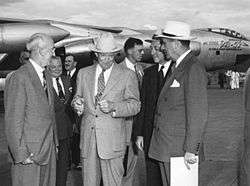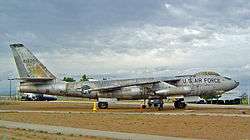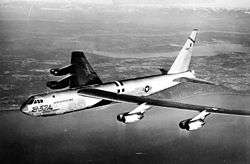New Look (policy)

The New Look was the name given to the national security policy of the United States during the administration of President Dwight D. Eisenhower. It reflected Eisenhower's concern for balancing the Cold War military commitments of the United States with the nation's financial resources. The policy emphasized reliance on strategic nuclear weapons to deter potential threats, both conventional and nuclear, from the Eastern Bloc of nations headed by the Soviet Union.
History

In its narrowest sense, the New Look was the name applied to the Department of Defense budget for Fiscal Year 1955, which was the first defense budget prepared entirely by Eisenhower's own Joint Chiefs of Staff. It was based on an extensive reappraisal of U.S. military requirements that began among Eisenhower and his closest advisers immediately following his election in November 1952.[1] It was formalized in National Security Council document 162/2 (NSC 162/2), which Eisenhower approved on October 30, 1953.
NSC 162/2 reflected Eisenhower's desire for a "long-haul" approach to security planning that would maintain a more or less constant level of military preparedness, consistent with the health of the U.S. economy.[2] In this respect, it differed from NSC 68, approved by President Harry S. Truman on September 30, 1950. Truman's advisers believed that Soviet military capabilities would reach a maximum relative to those of the United States and its allies in the mid-1950s.[3]
Eisenhower rejected the idea that one period would be any more dangerous than another and urged his planners to think in terms of a Soviet threat that was economic as well as military. He wanted to avoid, in his own words, "an unbearable security burden leading to economic disaster."[3] With the costly experience of the Korean War in mind, Eisenhower was fearful that U.S. resources would be drained by Soviet-inspired regional conflicts.[4]
Massive Retaliation and the New Look


In order to contain defense costs, the New Look brought about a shift in emphasis from conventional military capability to "air-atomic" capability in the form of the Strategic Air Command within a scaled-down overall military establishment. Land and naval forces were cut. Continental air defense was expanded. Although strategic air power attained a lower level than the Truman administration had projected, it became the centerpiece of U.S. security thinking, embodied in the doctrine of "Massive Retaliation." Summarized in the popular slogan "more bang for the buck," Massive Retaliation was intended to be both a deterrent to an enemy and an economy of scale if deterrence failed. [5]
The doctrine was proclaimed in its most absolute form by Secretary of State John Foster Dulles in a speech before the Council on Foreign Relations on January 12, 1954, in which he said, "Local defenses must be reinforced by the further deterrent of massive retaliatory power [emphasis added].6 Dulles continued:
The way to deter aggression is for the free community to be willing and able to respond vigorously at places and with means of its own choosing.
...
Now the Department of Defense and the Joint Chiefs of Staff can shape our military establishment to fit what is our policy, instead of having to try to be ready to meet the enemy's many choices. That permits of a selection of military means instead of a multiplication of means, As a result, it is now possible to get, and share, more basic security at less cost.[7]
Criticism of Massive Retaliation
What Dulles implied was that the United States was prepared to respond to a Soviet-backed conventional threat anywhere with a nuclear strike against the Soviet Union itself. [8] Critics of Massive Retaliation such as historian John Lewis Gaddis have pointed out that the doctrine was not credible in the face of "less-than-total challenges" such as the Soviet intervention in the 1956 Hungarian Revolution, and that whatever credibility it might have had diminished steadily as Soviet strategic power grew.[9] Furthermore, it theoretically provided the Soviet Union with an incentive to strike first to disarm the United States.
The "New" New Look

The refusal of the United States to act to prevent the defeat of France by the Communist-led Viet Minh at the Battle of Dien Bien Phu, just four months after the Dulles speech, was proof that a situation of "mutual deterrence" had developed with the Soviet Union in which the use of strategic nuclear weapons for any purpose other than to respond to a direct attack on one's homeland or on one's major allies was out of the question. Defense planners, therefore, began shaping a "new" New Look marked by emphasis on strategic "sufficiency," not superiority; on tactical nuclear weapons to fight "limited wars;" and on standing forces as opposed to reserves.[10] The emphasis was still primarily on nuclear weapons and the justification was still that of economy, but a shift toward what would later be called "flexible response" had begun.
The new approach was embodied in NSC 5440, finalized in December 1954, which stated:
The ability to apply force selectively and flexibly will become increasingly important in maintaining the morale and will of the free world to resist aggression. As the fear of nuclear war grows, the United States and its allies must never allow themselves to get into the position where they must choose between (a) not responding to local aggression and (b) applying force in a way which our own people or our allies would consider entails undue risk of nuclear devastation. However, the United States cannot afford to preclude itself from using nuclear weapons even in a local situation, if such use. . . will best advance U.S. security interests. In the last analysis, if confronted by the choice of (a) acquiescing in Communist aggression or (b) taking measures risking either general war or loss of allied support, the United States must be prepared to take these risks if necessary for its security.[11]
According to historian Campbell Craig:
NSC 5440 was a fundamental revision of the earlier BNSP [Basic National Security Policy]. Its authors (a) renounced massive retaliation, (b) precisely articulated the strategy of "flexible response" as it would become known seven years later, and (c) predicted, in the last sentence, exactly the dilemma which the Eisenhower administration would face in Berlin four years hence. [12]
Notes
- 1. Herman S. Wolk, "The 'New Look'," Air Force Magazine, v. 65, no. 8, (August 2003). ISSN 0730-6784
- 2. Samuel P. Huntington, The Common Defense, New York: Columbia University Press, 1961, pp. 67–68. ISBN 0-231-08566-4
- 3. Quoted in Huntington, p. 66.
- 4. Wolk.
- 5. Huntington, pp. 79–80.
- 6. Quoted in Bernard Brodie, Strategy in the Missile Age, (Princeton, NJ: Princeton University Press, 1959, p. 248.
- 7. Id., pp. 248–249. McGeorge Bundy, a national security adviser to Presidents John F. Kennedy and Lyndon B. Johnson, states that President Eisenhower, although initially put off by the phrase "massive retaliatory power," not only approved the Dulles speech, but had a hand in drafting it. McGeorge Bundy, Danger and Survival, New York: Random House, 1988, p. 256. ISBN 0-394-52278-8
- 8. This was not a new theme for Dulles. In a 1952 article for Life magazine, he wrote: "There is one solution and only one: that is for the free world to develop the will and organize the means to retaliate instantly against open aggression by Red armies, so that, if it occurred anywhere, we could and would strike back where it hurts, by means of our choosing." John Foster Dulles, '"A Policy of Boldness," Life, May 19, 1952, p. 151. Quoted in Townsend Hoopes, The Devil and John Foster Dulles, (Boston: Little, Brown & Co., 1973), p. 127. ISBN 0-316-37235-8 Dulles, however, was not alone in suggesting a nuclear response to a conventional threat. On January 11, 1951, at the height of the Korean War, former Secretary of the Air Force Stuart Symington, then chair of the National Security Resources Board, sent President Truman the draft of NSC-100, which proposed using nuclear weapons not only against China, which was engaged in active combat with U.S. forces, but also against the Soviet Union, which was believed to be conducting the war through China. Truman rejected the memorandum. James Carroll, House of War, Boston & New York: Houghton Mifflin Co., 2006, pp. 193, 202. ISBN 0-618-18780-4
- 9. John Lewis Gaddis, Strategies of Containment: A Critical Appraisal of Postwar American National Security New York: Oxford University Press, 1982. ISBN 0-19-517448-8
- 10. See generally, Huntington, pp. 88–100. Huntington uses the term "New New Look." So does George E. Lowe, The Age of Deterrence, Boston: Little, Brown & Co., 1964, p. 89. Apparently without access to the then-classified NSC 5440, Huntington placed the beginning of the "New New Look" in December 1955 when Department of Defense planners began budget preparations for fiscal years 1958, 1959 and 1960.
- 11. Quoted in Campbell Craig, Destroying the Village: Eisenhower and Thermonuclear War New York: Columbia University Press, 1998, chapter 3. ISBN 0-231-11123-1
- 12. Id.
Other reading
- Robert R. Bowie and Richard H. Immerman, Waging Peace: How Eisenhower Shaped an Enduring Cold War Strategy Oxford, New York: Oxford University Press, 1997. ISBN 0-19-506264-7
- Paul Y. Hammond, Organizing for Defense, Princeton, NJ: Princeton University Press, 1961.
- Richard G. Head and Ervin J. Rokke (eds.), American Defense Policy (3rd ed.), Baltimore: Johns Hopkins University Press 1975. ISBN 0-8018-1486-3
- William R. Kintner, Peace and the Strategy Conflict, New York: Frederick A. Praeger, 1967.
- Walter Millis (ed.), American Military Thought, Indianapolis: Bobbs-Merrill Co., 1966.
- Robert E. Osgood, Limited War, Chicago: University of Chicago Press, 1957.
- Warner R. Schilling, Paul Y. Hammond and Glenn H. Snyder, Strategy, Politics and Defense Budgets, New York: Columbia University Press, 1962. ISBN 0-231-02556-4
- Maxwell D. Taylor, The Uncertain Trumpet, New York: Harper & Row, 1960.
External links
- Herman S. Wolk, "The 'New Look'," Air Force Magazine, v. 65, no. 8, (August 2003)
- Summary: John Foster Dulles, "The Evolution of Foreign Policy," Department of State Bulletin 30 (January 25, 1954): 107-10
- Summary: John Lewis Gaddis, Strategies of Containment: A Critical Appraisal of Postwar American National Security (Oxford University Press, 1982)
- Documents on Canadian External Relations: UNITED STATES DEFENCE POLICY: A "NEW LOOK," February 2, 1954
- "The Rise and Fall of Massive Retaliation, January 1953–July 1955" from Campbell Craig, Destroying the Village: Eisenhower and Thermonuclear War (New York: Columbia University Press, 1998)